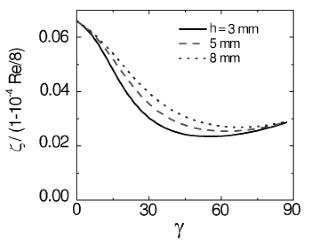螺旋损伤柱流动的水力阻力模型
IF 1.3
4区 工程技术
Q3 ENGINEERING, MECHANICAL
引用次数: 0
摘要
建立了LNG螺旋缠绕塔压力损失计算模型。该模型采用三流方案:两个倾斜涡流在管壁间空间,由沿柱轴线的中心流分开。基于积分动量平衡定理,推导了液压阻力系数的计算公式。为了验证计算模型的结果,建立了实验装置并进行了实验。用该模型计算的水力阻力系数与实测实验数据比较,结果吻合较好。本文章由计算机程序翻译,如有差异,请以英文原文为准。

Model of the Hydraulic Resistance for the Flow in a Spiral Wounded Column
A model for calculating pressure losses in a spiral wound LNG column has been developed. The model uses the scheme of three flows: two inclined vortex flows in the wall inter-tube spaces, separated by the central flow along the axis of the column. Based on the integral momentum balance theorem, a formula for the hydraulic drag coefficient was derived. To verify the results of the computational model, an experimental setup was built and experiments were conducted. Comparison of the calculations of the hydraulic resistance coefficient according to the model with the measured experimental data shows good agreement.
求助全文
通过发布文献求助,成功后即可免费获取论文全文。
去求助
来源期刊

Journal of Engineering Thermophysics
THERMODYNAMICS-ENGINEERING, MECHANICAL
CiteScore
2.30
自引率
12.50%
发文量
0
审稿时长
3 months
期刊介绍:
Journal of Engineering Thermophysics is an international peer reviewed journal that publishes original articles. The journal welcomes original articles on thermophysics from all countries in the English language. The journal focuses on experimental work, theory, analysis, and computational studies for better understanding of engineering and environmental aspects of thermophysics. The editorial board encourages the authors to submit papers with emphasis on new scientific aspects in experimental and visualization techniques, mathematical models of thermophysical process, energy, and environmental applications. Journal of Engineering Thermophysics covers all subject matter related to thermophysics, including heat and mass transfer, multiphase flow, conduction, radiation, combustion, thermo-gas dynamics, rarefied gas flow, environmental protection in power engineering, and many others.
 求助内容:
求助内容: 应助结果提醒方式:
应助结果提醒方式:


